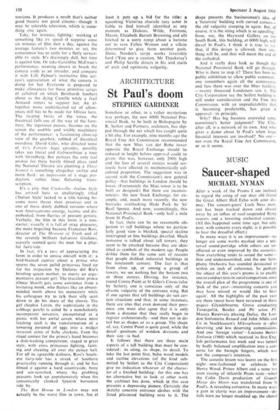MUSIC Saucer-shaped
MICHAEL NYMAN
After a week of the Proms I am inclined to regard the axing of our dear old friend the Great Albert Hall Echo with utter dis- may. The concert-goers' Loch Ness mon- ster has been tracked down and chased away by an influx of roof-suspended flying saucers and a lowering orchestral canopy. (All this happened some time ago, but only now, with concerts every night, is it possible to hear the dreadful effect.)
In many ways it is an improvement—no longer are some works mashed into a uni- versal sound-porridge while others are un- affected or even improved by the acoustics. Now everything tends to sound the same— thin and undernourished, and the BBC Sym- phony Orchestra has sounded dessicated to within an inch of coherence. So perhaps the object of this year's proms is to enable one to conduct tests in aural comparison, since the overall plan of the programme is one of 'pick of the year—interesting concerts you may have missed or would like to hear again'. All the highlights of the past year are there (most have been reviewed in these pages)---Glyndebourne, Grove conducting Turangalila, Boulez and Pli selon Pli. Musica Reservata playing Dufay, the Lon- don Sinfonietta Renard and John Alldis and Co in Stockhausen's Mikrophonie 11—plus deserving and less deserving commissions. And one 'foreign visitor'—Luciano Berio's Sinfonia (1968) which received its first Eng- lish performance last week and was turned by badly balanced amplification into a con- certo for the Swingle Singers, which was not the composer's intention.
The acoustic lesson was learnt on the first night—new-fashioned to celebrate Sir Henry Wood. Prince Albert and a none too soon raising of infantile Prom taste—when the Colin Davis production of Grande Messe des Marts was transferred from St Paul's. A revealing corrective. In many ways a gain in clarity was an improvement—de- tails were no longer muddied up, the choral tone, given a lethal cutting edge by those versatile boys from Wandsworth, shone up hazeless; the brass entry in the Tuba Mirum again opened the door to sensations which no amount of Stockhausen will ever dim- inish, even though coordination of the four bands in the top gallery was staggered like four slightly out of phase tape-recorders; the closing Amens were lovingly shaped, and, of course, there was Ronald Dowd trying to be as French as possible by sliding from note to note in an exuberant over- flow of vocal incense.
But still a corrective, which for me rather diminished Davis's stature as a Berlioz ex- pert, though he has an undeniable flair for the theatrical. I am sure it was not only the deadening acoustic which drained all the colour from the severe lines of the Requiem. Lachrymosa, which in St Paul's had admittedly sounded a mess, seemed in the Albert Hall to be merely wet and flabby- Davis's approach had a stiff-upper-lip, very British determination but little else. The ardour and morbid melancholy which Ber- lioz demanded from his conductors in order to bring out the expressive fire of his music seems at the moment to be eluding Davis.
A few days later Charles Mackerras con- ducted a performance of another monu- ment to musical-religious impracticability, Bach's Mass in D Minor. This again showed that choirs come off best in the resonance-gutted Hall; just as the previous night revealed that wind instruments knock the piano into a very inferior second place (even when it is played heroically by John Ogdon, as he did in the Stravinsky piano concerto). And that—I promise not to men- tion the subject again—if you cut down the number of performers to idiomatic Bach proportions, little or nothing will be pro- jected beyond the 6-plan orchestral canopy...
Mackerras's performance was very care- fully calculated not to allow the heat of the eyeing to melt Bach's intensively-wrought polyphony or wilt the audience into apathy. Tempi were consistently, but rarely reck- lessly, speedy and by not hanging around reverentially at the end of each section all those final cadences of all those movements were partially robbed of their finality to create an uncommon sense of purpose and feeling for the architectural whole.
But such an interpretation has its dan- gers. Certainly wildly paced choruses con- jure up that joyousness which counter- balances the all too frequent performances reeking of religiosity and musicology. But the musicologists are surely right when they point out that fast Bach is often unidio- matic Bach. In keeping with the fast move- ments the slow ones were taken at a com- fortable amble and sung nothing more than charmingly by the four soloists. The amb- ling is not the only alternative to the pon- derous, and it is this very necessary quality which was lacking in the opening Kyrie. That movement and the Agnus Dei are for me two touchstones of a good per- formance.
Mackerras missed the scrupulous rise and fall of the intervals of the fugue theme and the measured march of the harmony (though he caught these very well in the Crucifixus). However, the Agnus Dei was superb. Janet Baker tragically cold, richly deadpan, was exactly right and dis- guised an effortlessly flexible mastery of phrasing and nuance. The final choral Dona Nobis was as much a homage to her sing- ing as it was to the glory of God.



































 Previous page
Previous page